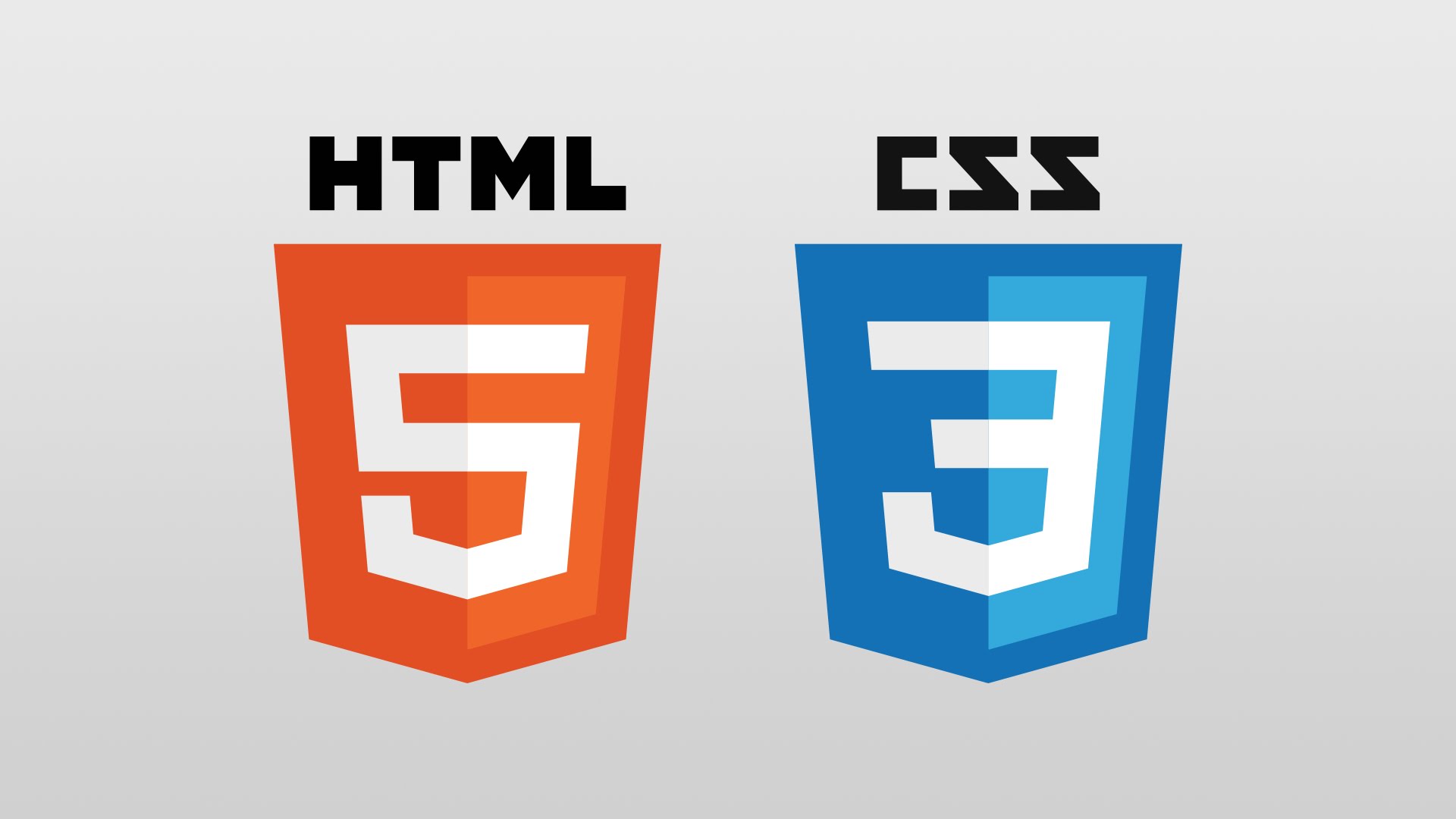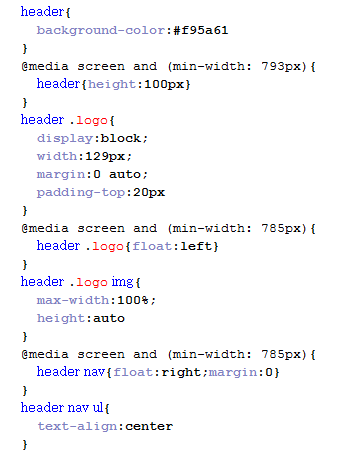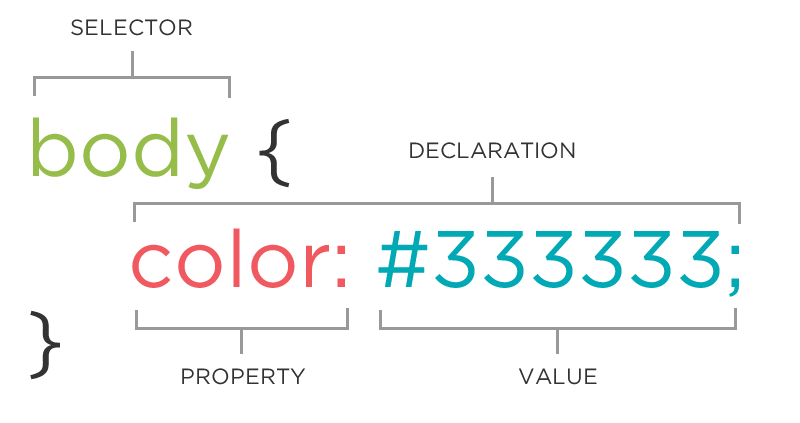
Intro to HTML/CSS
Class 2
Quiz Part 1
Which tag is used to create a link to another page?
- <p>
- <link>
- <a>
- <america>
Quiz Part 2
What are the two tags that nest directly within the <html> tags?
Quiz Part 3
What is it called when you have a 'tag' + 'content' + 'closing tag'?
Let's Review

Anatomy of a website
Your Content
+ HTML: Structure
+ CSS: Presentation
= Your Website
A website is a way to present your content to the world, using HTML and CSS to present that content & make it look good.
CSS: What is it?
CSS = Cascading Style Sheets
CSS is a "style sheet language" that lets you style the elements on your page.
CSS is works in conjunction with HTML, but is not HTML itself.
CSS: What can it do?
All colored text, position, and size

CSS: What does it look like?

The CSS Rule

The CSS Rule
selector {
property: value;
}
- A block of CSS code is a rule.
- The rule starts with a selector.
- It has sets of properties and values.
- A property-value pair is a declaration.
Connecting CSS to HTML
3 ways
"Inline"
"Embedded"
"External"
Connecting CSS to HTML: Inline
<p style="color:red">Some text.</p>
Uses the HTML attribute style.
Difficult to use in large projects
Not preferred.
Connecting CSS to HTML: Embedded
<head>
<style type="text/css">
p {
color: blue;
font-size: 12px;
}
</style>
</head>
Inside <head> element.
Uses <style> tag.
Can only be used in one html file
Connecting CSS to HTML: Linked
<head>
<link rel="stylesheet" type="text/css" href="style.css">
</head>
- Shared resource for several pages.
- Reduced file size & bandwidth
- Easy to maintain in larger projects.
- Preferred by nerds everywhere!
Let's develop it
- Find the CSS folder, locate the default.css and the layout.css
- Add a link to the file in the head of your HTML file.
- Create a new custom.css file and save it in the css folder (Don't worry about adding content yet!). Link to this new file underneath the rest of the css links in the head tag
CSS Syntax
Declarations: Property and value of style you plan to use on HTML element.
Declarations end with a semicolon
Declaration groups are surrounded by curly brackets.
selector {
property: value;
property: value;
property: value;
}
Selector: Element
p {
property: value;
}
Selects all paragraph elements.
img {
property: value;
}
Selects all image elements.
CSS Color Values
Your browser can accept colors in many different ways:
- Color name (ex. red)
- Hexadecimal value (ex. #FF0000)
- RGB value (ex. rgb(255, 0, 0))
- HSL value (ex. hsl(0, 100%, 100%))
The 17 standard colors are: aqua, black, blue, fuchsia, gray, grey, green, lime, maroon, navy, olive, purple, red, silver, teal, white, and yellow.
Property: Color
The color property changes the color of the text.
p {
color: red;
color: #ff0000;
color: rgb(255, 0, 0);
}
Property: Background-color
The background-color property changes the color of the background.
p {
background-color: black;
background-color: #000000;
background-color: rgb(0,0,0);
}
Let's develop it
- Add some rules to your css file
- Change the font color and background color of different types of elements
- Try selecting links, paragraphs, and lists
Property Values
Each property can have one or more comma separated values.
p{
color: white;
background-color: red;
font-family: Arial, sans-serif;
}
Property: Font-family
The font-family property defines which font is used.
p {
font-family: "Times New Roman";
font-family: serif;
font-family: "Arial", sans-serif;
}
Specific font name
Generic name
Comma-separated list
Property: Font-size
The font-size property specifies the size of the font.
p {
font-size: 12px;
font-size: 1.5em;
font-size: 100%;
}
Pixels
"em"
Percentage
Property: Fonts (shorthand)
p {
font-style: italic;
font-weight: bold;
font-size: 10px;
font-family: sans-serif;
}
p {
font: italic bold 10px sans-serif;
}
Let's develop it
- Change the fonts of your page
- Try changing the font sizes and styles for different elements
Selector: Position
p em {
color: yellow;
}
Selects all em elements that are within a paragraph
<p>This is <em>important.</em></p>
The associated HTML.
Selector: Position
- Position selectors are more specific
- They look for elements inside other elements
- We seperate nested elements with a space
Selector: Position
So this code:
ul li a strong{
color: purple;
}
Means "find a strong tag inside a link inside a list item in an unordered list"
<ul>
<li><a href="programs.html">Our <strong>program</strong></a></li>
</ul>
Let's develop it
- In your CSS file, try a position selector
- Remember, you need to look for an element inside another element
Reusing code
As a general coding principle, Don't Repeat Yourself.
To reuse CSS, we use IDs and classes.

IDs vs. Classes
ID -- Should only apply to one element on a webpage, i.e., a webpage only has one footer.
The "#" is how you tell CSS "this is an id."
Class -- Lots of elements can have the same class, i.e., There can be many warnings on one webpage.
The "." is how you tell CSS "this is a class name."
Selector: ID
#footer {
property: value;
}
Selects all elements with an id of "footer".
<p id="footer">Copyright 2011</p>
The associated HTML.
Selector: Class
.warning {
color: red;
}
Selects all elements with a class of "warning".
<p class="warning">Run away!</p>
The associated HTML.
Let's develop it
- Add class "Button" to your LinkedIn and Email link
- Add an new ID and class to a your HTML. For example, add an class to the first row in your education section, and give it a different background color.
- Add CSS rules to target these elements
Cascading
Styles "cascade" down until changed
p{
color:blue;
font-family: 'Helvetica';
}
.red {
color: red;
}
#special {
font-family: Arial;
}
<p>Paragraph</p>
<p class ="red">Paragraph</p>
<p class = "red" id ="special">Paragraph</p>
Cascading priority
Your browser assigns different priorities to CSS depending on the type of selector.
- Important! - Most Important
- In line CSS
- ID
- Class
- Element - Least Important
Cascading priority
Your browser also assigns priority based on the specificity of the selection. More specific selectors have higher priority.
.main .sale .clearance p{ //Most specific
color: red;
}
.header .title p{
color: green;
}
.footer p{ //Least specific
color: blue;
}
Cascading priority
The tie-breaker is position. Rules lower in the file overwrite rules higher in the file
a{
background-color: yellow;
}
a{
background-color: teal;
}
a{ //This rule wins
background-color: black;
}
CSS Properties
Many CSS properties have self-explanatory names:
- background-color
- font-family
- font-size
- color
- width
- height